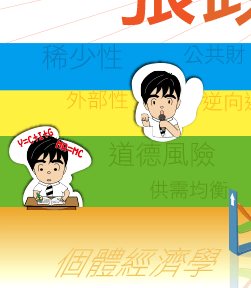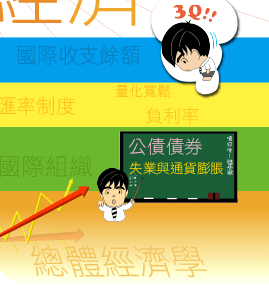




The incumbent firm and all potential entrants have marginal cost=2 in an industry with inverse demand ![]() for a homogeneous product.
for a homogeneous product.
(1)Suppose that 2 new firms enter (at zero fixed cost) but that post-entry competition is described by the basic Cournot model. And the corresponding payoffs (profits)![]()
(2)And suppose that there are entry barriers such that incumbents must sink a cost of K=25 in order to enter. In subgame perfect Nash equilibrium, how many firms will enter if post-entry competition is Bertrand![]() ? If it is Cournot
? If it is Cournot![]()
[ 解答 ]
(1) 題目說明市場內已有一家既存廠商,與兩家後進廠商 (2 、 3) ,所以 Stackelberg 與 Cournot 模型的混合,由既存廠商為領導者,而兩家後進廠商為追隨者,故以序列賽局的角度,應由後向前解
Stag1 先解 Followrs 決策,給定 Leader 已經決定產量Q1 Followrs 極大利潤決策
第 2 廠商決策
第 3 廠商決策
將 (a) 、 (b) 兩式聯立求解可得到 代入 Leader 的目標函數
代入 Leader 的目標函數

(2) 若後進者仍為 Bertrand 競爭,但有進入成本,而產品同質 ( ∵三家廠商面對相同的需求函數 ) 且邊際成本相同,由理論可知,價格競爭的結果 ,故既存廠商![]() ,但後進廠商必須付出 K=25 的進入成本,故
,但後進廠商必須付出 K=25 的進入成本,故![]() ,則選擇不進入市場,所以均衡廠商家數
,則選擇不進入市場,所以均衡廠商家數![]()
之,若改為 Cournot 競爭,由第一小題可知,原本![]() ,但即使付出 K=25 的進入成本,新的利潤
,但即使付出 K=25 的進入成本,新的利潤![]() ,仍有誘因進入市場,所以均衡廠商家數
,仍有誘因進入市場,所以均衡廠商家數![]()
- 面授課程:高普考
- 雲端課程:經濟學、公共經濟學、財政學、租稅各論
- 考試用書:經濟學(概要)、經濟學測驗題完全制霸、財政學大意歷屆試題分章題解

